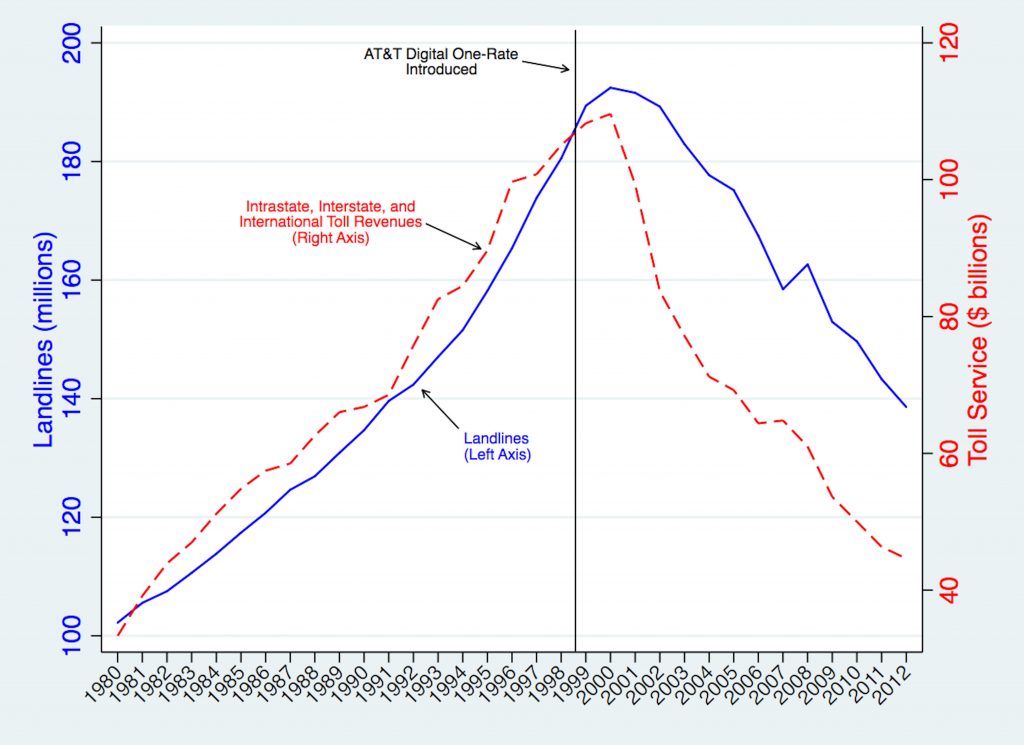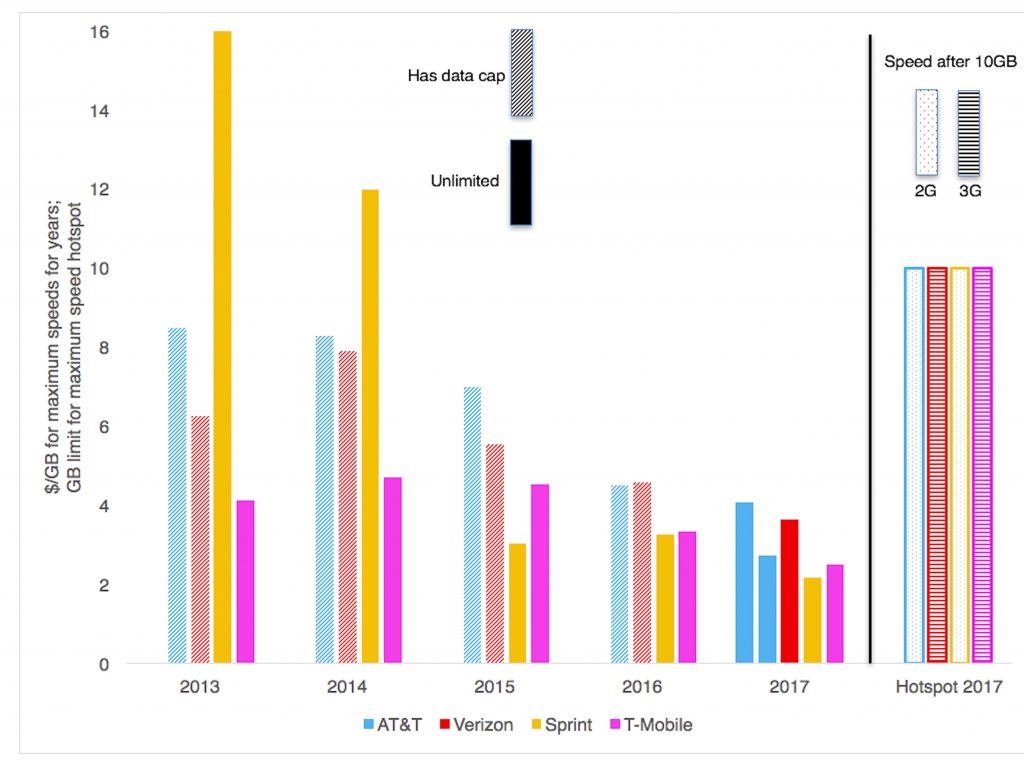The Holy Grail in cellular wireless broadband is a perfect substitute for fixed, wireline broadband. It’s already a substitute for some uses and users, meaning competition analysis should take into account this imperfect competition for policymaking purposes. But the technologies are not yet substitutes for most households.
Verizon’s recent (re-)introduction of its unlimited data plan, however, suggests that day may be in sight.
While history never provides a perfect analogy, let’s take a step back in time to the days of in-country roaming and long-distance wireless charges. (Like cavemen, we were in the 1990s!)
In 1998, AT&T rocked the industry with its “Digital One Rate” plan, which eliminated roaming and long-distance. It thus became possible to call from anywhere to anywhere in the country at no additional cost.
Digital One Rate did not offer unlimited calling at first—that would come later. However, it offered big enough “buckets” of minutes, with low enough overage prices, that it became possible for people to consider ditching their landlines. Walt Mossberg noted in July 1999 that “[i]t promises to make your cell phone as simple and affordable to use as a land-line phone, so that you’ll use it even for casual calls without a second thought.”
The number of households with landlines began to plummet. Domestic long-distance largely disappeared. Today, voice is just a commodity, and it is possible to purchase it in increments from one to unlimited minutes.
Figure 1: Number of Landlines and Long-Distance Revenues, 1980-2012
Source: FCC
Could Verizon’s new unlimited data plan be the harbinger of similar developments in data transmissions?

The Magic 8-Ball says “signs point to yes.”
T-Mobile and Sprint have long differentiated themselves by offering unlimited data plans. Their networks were not as built out as the bigger carriers’ networks, but they competed by offering plans that did not charge for exceeding data limits. Verizon’s decision to offer unlimited data—and AT&T’s immediate match—matters because the providers with reputations for higher quality now believe their networks are robust enough to handle the additional traffic without hurting those reputations. T-Mobile and Sprint have already responded to these offers by increasing the amount of data transfer allowed before slowing the service (T-Mobile) or cutting the price of their service (Sprint).
Figure 2 shows the evolution of cellular mobile data plans. The figure shows that prices have steadily decreased, and now all four major carriers offer unlimited data plans, including mobile hotspots.
Figure 2: Evolution of Mobile Data Plans 2013-2017
Sources: Press reports and company websites.[2]
Note: $/GB for unlimited calculated using the amount of data allowed before the carrier reduces data transfer speeds.[3]
In short, mobile wireless providers are steadily making it easier and less costly to buy data in varying increments, from pay-as-you-go to unlimited. All four carriers offer practically unlimited video streaming on the device itself, which matters as consumers increasingly consume video on their smartphones. Their hotspot connectivity can help bridge the “homework gap.” This evolution allows more people to treat wireless service as a substitute for wireline broadband, and as more people can use it as a substitute, the more price pressure it will put on wireline broadband.

A second query of the 8-Ball, however, about whether this is the data One-Rate moment yields “reply hazy try again.”
A perfect cellular wireless substitute for a landline connection would allow as much video streaming on larger screens, like a TV, via a hotspot-like connection as would fixed wireline broadband. In other words, if I wouldn’t consider connecting my Roku box to my mobile hotspot, then I can’t get rid of my wireline connection. Most households are probably in that group.
The hotspots—using the phone as a wifi router—available with the mobile plans all have 10 GB caps for full LTE speeds. After that they continue to offer unlimited data transfer, but at slower, 3G or 2G, speeds. 3G speeds can be 3-4 Mbps, which is generally good enough for SD video and some HD video, but with little margin for tolerating lower speeds and not capable of supporting multiple simultaneous streams.
Wireless data limits for triggering reduced speeds are likely to remain until wireless networks can truly handle the crush of video traffic that flows into our homes. AT&T’s network suffered from some congestion problems for a time after it introduced Digital One Rate. Mossberg, in the second half of the sentence quoted above added, “®he very popularity of the service has overloaded AT&T’s network at times, making it hard to place or receive calls. And, in my experience, the system has a maddening number of dead spots in big cities, where calls get suddenly cut off.”[1] AT&T faced similar congestion problems when the iPhone’s popularity made the unlimited data plan it had then untenable. Carriers are unlikely to allow an unlimited flood of HD video streams on their networks as long as it comes with a reasonably high likelihood of generating congestion.
Some activities may always require fixed lines, given their inherent better security and ability to maintain a consistent level of quality. But even if we’re not at the One Rate singularity yet, perhaps it is close.
Now that wireless coverage is nearly ubiquitous, except in some rural areas, investment is increasingly focused on handling more capacity. The primary way to do this is to add more cell sites for network “densification” in the mind-numbing jargon of the industry in which an adjective is nounified and then used as a verb. The rollout of 5G wireless service is expected to play an important role in radically increasing the capacity of wireless networks.
Competition doesn’t have to be perfect to affect prices. Every improvement in wireless quality and reduction in prices makes the two services more interchangeable for more people. We will get to the One-Rate moment, it’s just a question of how long.
On the other hand, we really shouldn’t be taking advice from a Magic 8-Ball.
[1] Walter S. Mossberg, “AT&T’s One-Rate Plan Falls Short of Promise For Broad, Easy Use,” The Wall Street Journal, July 8, 1999, sec. B1.
[2] 2013 Verizon plan required signing up for Edge Upgrade service. http://www.theverge.com/2013/8/26/4661358/verizon-max-data-plans-dirt-cheap-only-available-to-edge-customers
AT&T offers two unlimited plans. The less expensive plan has maximum speed of 3 Gbps and no mobile hotspot. https://www.att.com/plans/unlimited-data-plans.html
2017 hotspots all offer LTE service up to 10 GB. After 10 GB, Verizon and T-Mobile offer unlimited 3G speeds and AT&T and Sprint offer 2G speeds.
Until 2015, Sprint lowered speeds after data limit of top 5% of customers. According to press reports, this was about 5GB. In 2013 the cap was set at 23GB. http://www.informationweek.com/mobile/mobile-business/sprint-to-throttle-unlimited-data-over-23gb/a/d-id/1322716
[3] $/GB is flawed as a metric since it goes to zero for any truly unlimited plan.
Magic 8-Ball images used under Creative Commons Attribution 2.0 license.
https://commons.wikimedia.org/wiki/File:Magic_8_Ball_-_Instrument_Of_Evil%3F_(2426454804).jpg
https://commons.wikimedia.org/wiki/File:Magic_8_Ball_-_Do_I_get_my_Christmas_wish%3F_(6521326205).jpg




